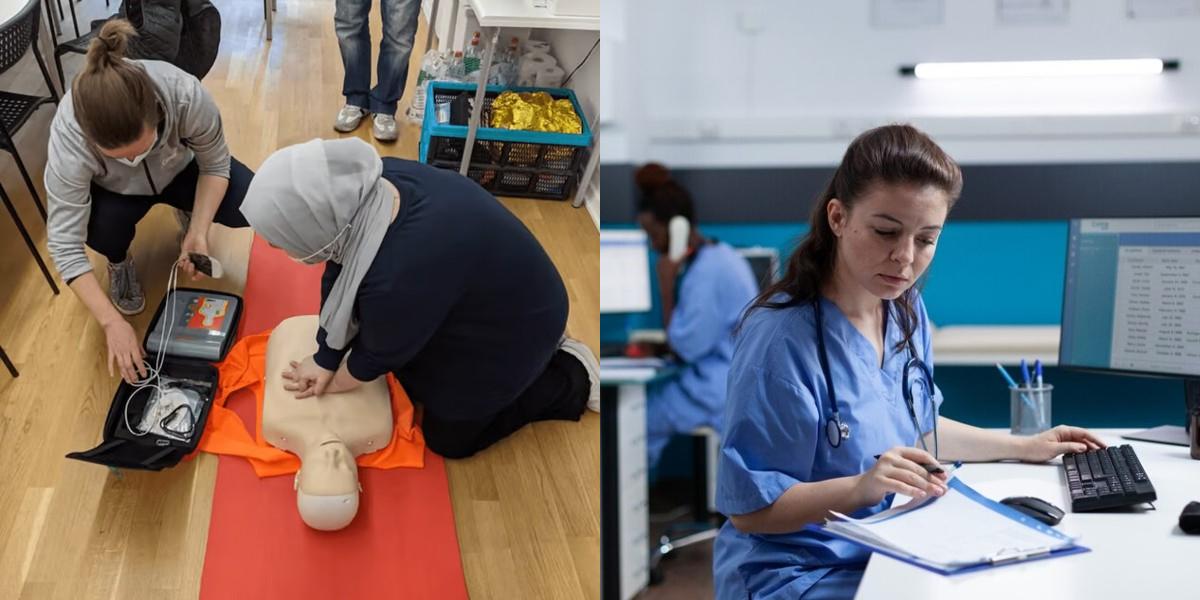CPR-BLS vs Healthcare Documentation Specialist
SearchCPR / Basic Life Support
classes near 43215

Key Points:
- CPR-BLS focuses on emergency medical care, while Healthcare Documentation Specialists handle medical records and documentation.
- CPR-BLS jobs are in high demand, especially in healthcare settings, while Healthcare Documentation Specialist roles are also in demand, particularly in hospitals and clinics.
- CPR-BLS training is typically done in person, while Healthcare Documentation Specialist training can be done online or in person.
- CPR-BLS training is generally shorter and less expensive than the training required for Healthcare Documentation Specialists.
The healthcare industry offers a wide range of career opportunities, and it's essential to find the best fit for your skills and interests. Whether you are interested in direct patient care or prefer a more administrative role, there are options available that can align with your career goals. Two such options are CPR-BLS and Healthcare Documentation Specialist.
What is CPR-BLS and Healthcare Documentation Specialist?
CPR-BLS (Basic Life Support)
CPR-BLS stands for Basic Life Support, and it is a certification that healthcare professionals need to obtain to provide emergency life-saving interventions. These interventions include cardiopulmonary resuscitation (CPR), use of an automated external defibrillator (AED), and relief of choking in adults, children, and infants. Healthcare professionals who are required to have a CPR-BLS certification include doctors, nurses, paramedics, and other allied health professionals.
Healthcare Documentation Specialist
A Healthcare Documentation Specialist, also known as a Medical Transcriptionist, is responsible for converting voice-recorded medical reports into written documents. They listen to recorded dictations from healthcare providers and transcribe them into accurate and complete medical reports. These reports are essential for patient records, insurance claims, and medical research. Healthcare Documentation Specialists must have excellent listening, typing, and grammar skills to ensure the accuracy of the transcribed documents.
CPR-BLS vs Healthcare Documentation Specialist
CPR-BLS (Basic Life Support) training provides essential skills for performing CPR and using an AED in emergencies, involving a short certification process. This training is often required for various healthcare and public safety roles. Healthcare Documentation Specialists manage and maintain accurate medical records and documentation, ensuring compliance and efficient healthcare delivery. Both roles are critical in healthcare but differ significantly: CPR-BLS focuses on emergency life-saving skills, while Healthcare Documentation Specialists focus on accurate medical record-keeping and compliance.
Difference between CPR-BLS and Healthcare Documentation Specialist
Although both CPR-BLS and Healthcare Documentation Specialist are important roles in the healthcare industry, they differ significantly in terms of job responsibilities and required skills.
CPR-BLS
-
Job Responsibilities:
- Perform CPR and other life-saving interventions in emergency situations.
- Assess the patient's condition and provide immediate medical assistance.
- Monitor vital signs and respond to changes in the patient's condition.
- Collaborate with other healthcare professionals in emergency situations.
-
Required Skills:
- Knowledge of CPR techniques and protocols.
- Ability to remain calm and focused in high-stress situations.
- Excellent communication and teamwork skills.
- Strong problem-solving and decision-making skills.
Healthcare Documentation Specialist
-
Job Responsibilities:
- Transcribe voice-recorded medical reports into written documents.
- Ensure the accuracy and completeness of medical reports.
- Edit and proofread transcribed documents for errors and inconsistencies.
- Maintain patient confidentiality and data security.
-
Required Skills:
- Excellent listening and typing skills.
- Strong attention to detail and accuracy.
- Knowledge of medical terminology and procedures.
- Proficiency in grammar and punctuation.
CPR-BLS vs Healthcare Documentation Specialist: Job Description
While both CPR-BLS and Healthcare Documentation Specialists play crucial roles in the healthcare industry, their job descriptions vary significantly.
CPR-BLS Job Description
As a CPR-BLS certified professional, your primary responsibility is to provide emergency life-saving interventions to patients in critical condition. You may work in various healthcare settings, such as hospitals, clinics, or ambulances, and be part of a team of healthcare professionals responding to emergencies. Your quick thinking, effective communication, and ability to perform CPR and other life-saving techniques can make a significant difference in the outcome for patients.
Healthcare Documentation Specialist Job Description
As a Healthcare Documentation Specialist, your primary responsibility is to transcribe voice-recorded medical reports into written documents. You may work in hospitals, clinics, or transcription services, collaborating with healthcare providers to ensure accurate and complete medical records. Your attention to detail and proficiency in medical terminology are critical to producing error-free and comprehensive medical reports.
CPR-BLS vs Healthcare Documentation Specialist: Education and Training
The education and training requirements for CPR-BLS and Healthcare Documentation Specialist differ significantly.
CPR-BLS Education and Training
To become a CPR-BLS certified professional, you need to complete a CPR-BLS certification course. These courses are typically offered by organizations such as the American Heart Association or the Red Cross. The courses cover topics such as CPR techniques, use of AEDs, and relief of choking in different age groups. The certification is valid for a specific period, usually two years, and requires renewal through additional training.
Healthcare Documentation Specialist Education and Training
To become a Healthcare Documentation Specialist, you typically need a post-secondary certificate or associate's degree in medical transcription or a related field. These programs provide training in medical terminology, anatomy, pharmacology, and transcription techniques. Some programs also offer hands-on experience through internships or practicums. While certification is not always required, it can enhance job prospects and demonstrate your proficiency in the field.
Get courses selected just for you
Try our powerful search engine
CPR-BLS vs Healthcare Documentation Specialist: Career Outlook and Salary
When considering a career path, it's essential to evaluate the career outlook and potential salary.
CPR-BLS Career Outlook and Salary
The demand for CPR-BLS certified professionals remains steady, as emergencies can occur at any time. Job opportunities can be found in hospitals, clinics, ambulance services, and other healthcare settings. The Bureau of Labor Statistics (BLS) does not provide specific data for CPR-BLS professionals but reports that employment of EMTs and paramedics, who often hold CPR-BLS certifications, is projected to grow 6 percent from 2019 to 2029. The median annual wage for EMTs and paramedics was $35,400 in May 2020.
Healthcare Documentation Specialist Career Outlook and Salary
The career outlook for Healthcare Documentation Specialists is influenced by advancements in technology and changes in healthcare documentation practices. As electronic health records become more prevalent, the demand for transcription services may decline. However, there will still be a need for specialists to edit and proofread transcriptions for accuracy. According to the BLS, employment of medical transcriptionists, including Healthcare Documentation Specialists, is projected to decline 2 percent from 2019 to 2029. The median annual wage for medical transcriptionists was $34,770 in May 2020.
Final Thoughts
Choosing a career path in the healthcare industry requires careful consideration of your skills, interests, and long-term goals. CPR-BLS and Healthcare Documentation Specialist are two distinct options, each with its unique set of responsibilities, education and training requirements, and career outlook. Whether you prefer the fast-paced nature of emergency response or the attention to detail in transcribing medical reports, there is a path for you in the healthcare industry.
Explore the reach of Dreambound's program in various locations. Dive into these blogs for an extensive look into the two vocations, including detailed information on their requirements and the process to join:

Fel is a student support representative who guides enrollees to the right program and answers their queries. She's committed to helping students and takes pride in her work. In her free time, she enjoys sightseeing and hanging out with loved ones.
